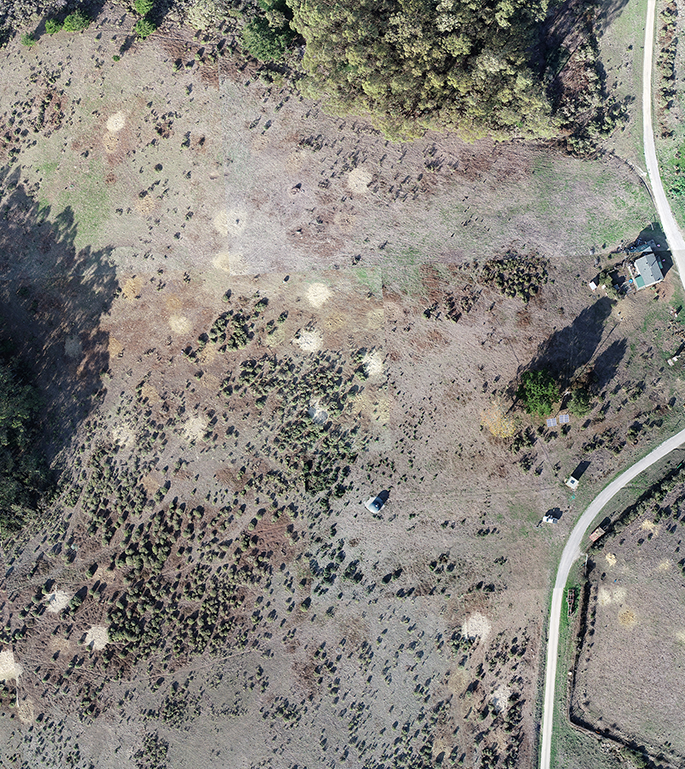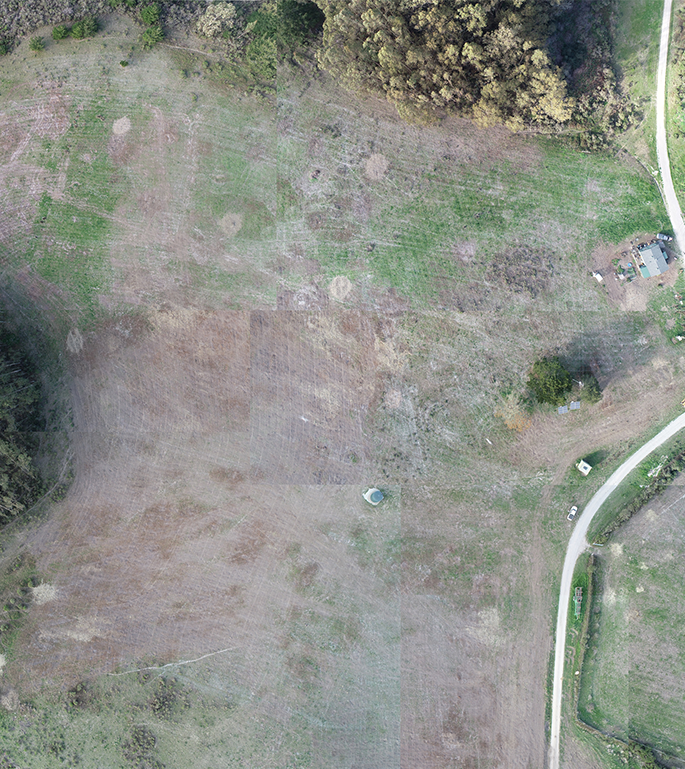Digging Deeper On Pasture Soils Trial: A Question and Answer Session with Ranch Manager Mark Biaggi.


TomKat Ranch circa 1950 compared to 2020.
Following Regenerative Ranching Coordinator Hayley Strohm’s discussion of TomKat’s on-going soil amendment trials, we did a Q & A session with Ranch Manager Mark Biaggi to dig deeper into the process and remediation steps employed at Fertility Flat, a windswept hilltop on the west side of the ranch. Over the years, an aggressively encroaching shrub species popularly known as coyote brush has increasingly spread over Fertility Flat. During the Pleistocene epoch, browsing megafauna species likely kept coyote brush, along with other woody species in the California coastal region, in check (Northern Coastal Scrub and Coastal Prairie page: 190). Later, the indigenous peoples of the region used fire as an effective tool to limit coyote brush expansion into grasslands. Today, however, many areas of California have no such controls to limit woody plant encroachment.
Q: Please describe the state of the pasture – its vegetation and soil conditions – prior to the trial.
A: In simplest terms, the field appeared tired and worn out. In some areas the briars and brush covered the field so thick you could barely walk, the soil was compacted and hard, and the plants weren’t flourishing. Soil tests indicated low calcium levels with a SOM (soil organic matter) level of 3.5%, normally indicative of a fairly productive field. However, Fertility Flats still lacked productivity. An agroecologist described the area as ‘sleepy soils’ while Nicole Masters, a soil scientist and friend who works with the ranch, called it ‘constipated’.


Q: Do you have any thoughts on how the pasture ended up in this condition? Is it a reflection of past management?
A: Knowing the history of a field is key to understanding the current state of the soils and vegetation. TomKat Ranch was historically managed as both a farm and ranch. Our records indicate farmers grew grain and hay in many of our fields as well as grazed livestock throughout the 20th century. In 2002, early TomKat Ranch management set-stock grazed Fertility Flat. In 2011, we began implementing rotational grazing practices and mowed regularly to control brush. For several years, we grazed cattle during the weaning season, a practice sometimes hard on a pasture, and rotationally grazed pasture-raised poultry as well. Despite our efforts to use practices typically thought to improve soil health—rotation, rest, poultry— Fertility Flat remains unproductive with unhealthy soils. We must improve soil health to facilitate production on the field; therefore we will continue to try new methods to improve the health of Fertility Flat.

Preparing the field.
Q: What is it you hope to achieve in this pasture?
A: Our goal is to ‘reset the table’ and awaken the microbial community in the soil. Over the years, brush and briars made up 50-90% of the plant population in the field. Such high levels of brush and briars outcompete native species, increase fire fuel levels, and lower field productivity. In practice, we plan to:
- Remove brush to create space on the land for increased diversity of plant species
- Feed the soil community with microbes from animal manure
- Seed new plants to increase diversity and abundance
- Minimize mechanical impact to avoid further soil compaction
Q: What steps did you take (vegetation removal, seeding, inoculant products) to “reset the table?”
A: The majority of the work took place in a relatively flat area of the field where we could easily operate a no-till drill (NTD).
Over a two-week period, we used a mini-excavator to pluck out all the medium to large brush. The unusually dry winter made our efforts to pull the entire plant and root structures of 12-18” more difficult than anticipated since the dry soil caused sections of the plant to break off, creating potential for regrowth. The small brush either escaped the excavator’s grasp or the branches broke away from the roots. The divots from the roots across 50% of the field give the appearance of a bad farming job.
We applied approximately 1,200 lbs of lime per acre in response to the low levels of calcium shown in the soil tests and mixed 150 lbs of humates per acre into the lime to feed the microbial community to balance the soil biology. Following the humates, we spread mature biochar at 150 lbs/acre, to feed the microbial community.

No-till seed drill (NTD) in action.
Q: It seems like a lot of work has already gone into regenerating this pasture. What kind of follow-up is necessary, if any?
A: To continue our trials, we will use foliar spray with biological amendments to strengthen plants post germination and also to continue to feed soil microbes. Throughout the balance of the growing season, we will let the land rest to allow for maximum germination and growth. Grazing will resume again in the fall or winter after the growing season has had the chance to produce the maximum plant growth that is possible given the weather this season.
In the future, we will integrate this field into the cattle grazing plan. Our cattle grazing plan entails planning, grazing, resting, monitoring, and adjusting for the conditions on the ground to reach our objectives for the field. We will monitor briars and brush for both regrowth from existing roots and for new germination (we anticipate both as we are managing for a highly diverse plant community).
A key focus of our monitoring efforts will be to observe if germination of new coyote brush can be controlled by short-duration, high-density grazing with accompanying ground impact through hoof action. We also plan to introduce grazing with goats to address any brush or briar return. Our Vegetation Management Plan (VPM) and Prescribed Burn Plan, developed with CalFire and starting in 2021, targets a section of this field to be burned (as a brush management tool) in 2-3 years (2023-24) if there is significant regrowth.
 TomKat Ranch Apprentice, Dillon Gruber, calls it a day.
TomKat Ranch Apprentice, Dillon Gruber, calls it a day.
Finding regenerative solutions that support the adaptation and resilience of agricultural lands to a warming climate is a prime motivation for our trial programs. Excess woody plants throughout California rangelands add to wildfire fuel sources, reduce biodiversity, and—among other things—contribute to declines in nutritious forage production and ecosystem function on prime agricultural lands. Revitalizing neglected and degraded rangelands is a vital climate mitigation effort, with benefits (such as carbon sequestration, fire tolerance, improved water infiltration, and higher levels of biodiversity) that reach beyond any one field or pasture. We look forward to continuing to share what we learn—the successes and challenges—from our trails program.